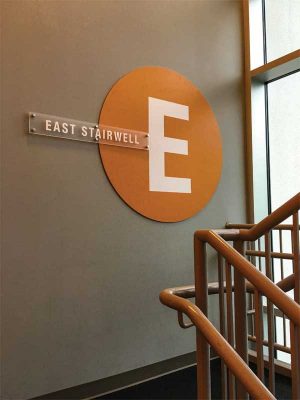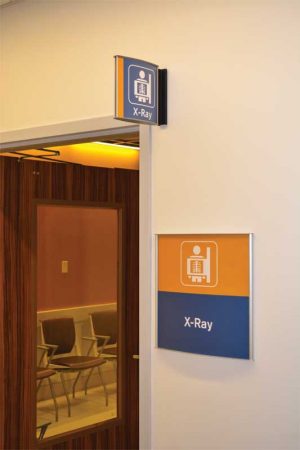Expert advice: Six steps for drafting wayfinding signage

Clear signage is specifically vital at a wayfinding system’s decision points, beginning with the initial directory or map and proceeding from there.
When creating wayfinding signage, there are six basic steps to consider.
- Discovery
Before beginning a design, it is vital for a planner to gather all of the significant data related to the site. It is often best to survey those who work or otherwise frequent the location. All relevant data should be documented and supported by photos. Designers should also determine the system’s message schedule, location maps, decision points, mounting situations, viewing distances/obstructions, and room numbers.
- Conceptualizing the design
Flushing out the specifics of a wayfinding design is typically done by a task force, along with other project decision-makers. Signmakers report their findings to these individuals and make recommendations based on these observations, and then discuss different approaches as well as review materials options and related budget considerations. User accessibility should be considered, as well as any requirements under the National Fire Code of Canada (NFC), the Standards Council of Canada (SCC), and any other local/federal organizations.
The system’s overall design should pick up on cues from the locations architectural environment, including interior and exterior features, as well as complement the colours and style of the brand. Planners should consider the site’s corporate culture in addition to the age, language proficiency, and education of its visitors.
- Final approvals
Once the design plan has been thoroughly developed, it must be submitted for approval. By this stage, time samples for sign selection would have been provided, prototypes would have been tested in selected locations, and a final budget/timeline would have been set. Further, room numbers (if applicable) have been reviewed and confirmed.
- Sign-off
By this phase, all stakeholders should have signed off on the sign schedule and site mapping. The system cannot move forward without these approvals. As such, a project’s production and installation begins with ensuring all elements and designated phases have been approved in writing.

Designers borrow visual cues within the built environment, which leave participants with a permanent mental image. Clear signage is specifically vital at a wayfinding system’s decision points, beginning with the initial directory or map and proceeding from there.
At this stage, the wayfinding team co-ordinates the system’s delivery and installation and production can begin. Temporary signs can be placed, as needed, within the work area, and a pre-determined schedule that co-ordinates with other trades that precede or follow the system’s installation can be posted.
- Review and report
Once all elements of a wayfinding system have been installed, the crew should perform a site inspection by conducting a walk-through. The project’s functionality should be thoroughly assessed, with corrections made when necessary. The team should then provide the site owner with a summary report.
- Sign standards
Sign standards are confirmed in a sign guide and are to be used by the client to maintain the continuity and appearance of the system for any future site changes and/or additions. The guide includes product literature and warrantees, the sign design manual, message schedule, location map, templates, and instruction for the re-ordering and internal permissions process.





